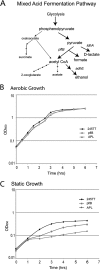Analysis of the proteome of intracellular Shigella flexneri reveals pathways important for intracellular growth
- PMID: 24101689
- PMCID: PMC3837999
- DOI: 10.1128/IAI.00975-13
Analysis of the proteome of intracellular Shigella flexneri reveals pathways important for intracellular growth
Abstract
Global proteomic analysis was performed with Shigella flexneri strain 2457T in association with three distinct growth environments: S. flexneri growing in broth (in vitro), S. flexneri growing within epithelial cell cytoplasm (intracellular), and S. flexneri that were cultured with, but did not invade, Henle cells (extracellular). Compared to in vitro and extracellular bacteria, intracellular bacteria had increased levels of proteins required for invasion and cell-to-cell spread, including Ipa, Mxi, and Ics proteins. Changes in metabolic pathways in response to the intracellular environment also were evident. There was an increase in glycogen biosynthesis enzymes, altered expression of sugar transporters, and a reduced amount of the carbon storage regulator CsrA. Mixed acid fermentation enzymes were highly expressed intracellularly, while tricarboxylic acid (TCA) cycle oxidoreductive enzymes and most electron transport chain proteins, except CydAB, were markedly decreased. This suggested that fermentation and the CydAB system primarily sustain energy generation intracellularly. Elevated levels of PntAB, which is responsible for NADPH regeneration, suggested a shortage of reducing factors for ATP synthesis. These metabolic changes likely reflect changes in available carbon sources, oxygen levels, and iron availability. Intracellular bacteria showed strong evidence of iron starvation. Iron acquisition systems (Iut, Sit, FhuA, and Feo) and the iron starvation, stress-associated Fe-S cluster assembly (Suf) protein were markedly increased in abundance. Mutational analysis confirmed that the mixed-acid fermentation pathway was required for wild-type intracellular growth and spread of S. flexneri. Thus, iron stress and changes in carbon metabolism may be key factors in the S. flexneri transition from the extra- to the intracellular milieu.
Figures


Similar articles
-
Contribution of the Shigella flexneri Sit, Iuc, and Feo iron acquisition systems to iron acquisition in vitro and in cultured cells.Infect Immun. 2003 Apr;71(4):1919-28. doi: 10.1128/IAI.71.4.1919-1928.2003. Infect Immun. 2003. PMID: 12654809 Free PMC article.
-
Role and regulation of iron-sulfur cluster biosynthesis genes in Shigella flexneri virulence.Infect Immun. 2008 Mar;76(3):1083-92. doi: 10.1128/IAI.01211-07. Epub 2008 Jan 14. Infect Immun. 2008. PMID: 18195027 Free PMC article.
-
Transcriptional adaptation of Shigella flexneri during adherence to epithelial cells.J Basic Microbiol. 2015 Feb;55(2):186-94. doi: 10.1002/jobm.201400414. Epub 2014 Oct 7. J Basic Microbiol. 2015. PMID: 25291620
-
Proteomes of pathogenic Escherichia coli/Shigella group surveyed in their host environments.Expert Rev Proteomics. 2014 Oct;11(5):593-609. doi: 10.1586/14789450.2014.935342. Epub 2014 Aug 28. Expert Rev Proteomics. 2014. PMID: 25163594 Review.
-
Molecular and Cellular Mechanisms of Shigella flexneri Dissemination.Front Cell Infect Microbiol. 2016 Mar 11;6:29. doi: 10.3389/fcimb.2016.00029. eCollection 2016. Front Cell Infect Microbiol. 2016. PMID: 27014639 Free PMC article. Review.
Cited by
-
The outer membrane phospholipase A is essential for membrane integrity and type III secretion in Shigella flexneri.Open Biol. 2016 Sep;6(9):160073. doi: 10.1098/rsob.160073. Open Biol. 2016. PMID: 27655730 Free PMC article.
-
Cellular Aspects of Shigella Pathogenesis: Focus on the Manipulation of Host Cell Processes.Front Cell Infect Microbiol. 2016 Mar 31;6:38. doi: 10.3389/fcimb.2016.00038. eCollection 2016. Front Cell Infect Microbiol. 2016. PMID: 27066460 Free PMC article. Review.
-
Analysis of the Escherichia coli extracellular vesicle proteome identifies markers of purity and culture conditions.J Extracell Vesicles. 2019 Jun 24;8(1):1632099. doi: 10.1080/20013078.2019.1632099. eCollection 2019. J Extracell Vesicles. 2019. PMID: 31275533 Free PMC article.
-
Pathogenicity and virulence of Shigella sonnei: A highly drug-resistant pathogen of increasing prevalence.Virulence. 2023 Dec;14(1):2280838. doi: 10.1080/21505594.2023.2280838. Epub 2023 Nov 23. Virulence. 2023. PMID: 37994877 Free PMC article. Review.
-
Mass spectrometry-based proteomic approaches to study pathogenic bacteria-host interactions.Protein Cell. 2015 Apr;6(4):265-74. doi: 10.1007/s13238-015-0136-6. Epub 2015 Feb 27. Protein Cell. 2015. PMID: 25722051 Free PMC article. Review.
References
-
- Ashida H, Ogawa M, Kim M, Suzuki S, Sanada T, Punginelli C, Mimuro H, Sasakawa C. 2011. Shigella deploy multiple countermeasures against host innate immune responses. Curr. Opin. Microbiol. 14:16–23 - PubMed
-
- Jennison AV, Verma NK. 2004. Shigella flexneri infection: pathogenesis and vaccine development. FEMS Microbiol. Rev. 28:43–58 - PubMed
-
- Menard R, Dehio C, Sansonetti PJ. 1996. Bacterial entry into epithelial cells: the paradigm of Shigella. Trends Microbiol. 4:220–226 - PubMed
-
- Nhieu GT, Sansonetti PJ. 1999. Mechanism of Shigella entry into epithelial cells. Curr. Opin. Microbiol. 2:51–55 - PubMed
Publication types
MeSH terms
Substances
Grants and funding
LinkOut - more resources
Full Text Sources
Other Literature Sources
Research Materials
Miscellaneous

